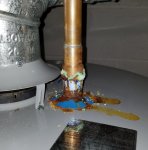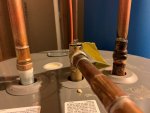RAKocher
Senior Member
- Location
- SE Pennsylvania
This is the hot water connection on a 4 month old electric hot water tank. This is not due to a leak. The cold water connection looks as pristine as it did on day one. The manufacturer, without hesitation and fully under warranty, is sending a new tank nibble along with a plumber to install it. The tank nipples are dielectric. I didn't give it a thought at the time, but the tank that this one replaced failed in the same manner. This is an emergency electric standby tank plumbed in parallel to an aprox 12 yr old heat exchanger tank heated by a propane boiler. The main tank's hot & cold water connections are perfect.
Should I bond the home's hot water pipe to the cold water pipe?
Should I bond the home's hot water pipe to the cold water pipe?




